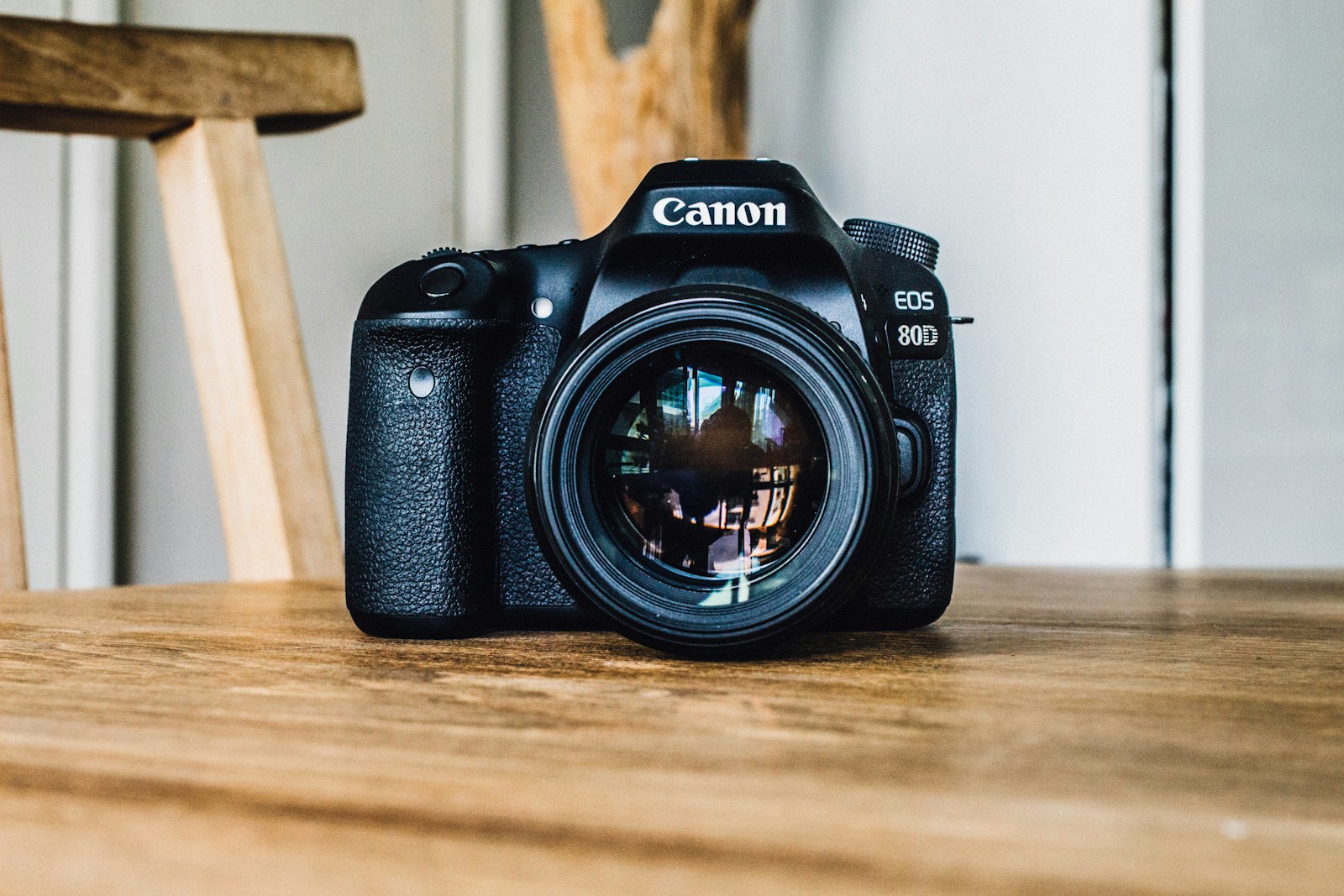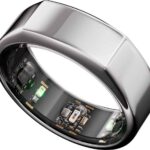Bird photography captures the beauty and behavior of birds in their natural habitats. A good camera for bird photography needs to balance performance with portability. Whether you’re watching backyard birds or traveling to exotic locations, the right equipment makes a big difference.
Bird photography presents unique challenges. Birds move quickly, often stay far away, and may be hidden in trees or bushes. The best cameras for bird photography have fast autofocus, good reach with telephoto lenses, and the ability to take sharp images in various lighting conditions.
When choosing a bird photography camera, pay attention to autofocus speed, sensor size, and burst rate. You’ll also want to consider weather sealing for outdoor use, battery life for long shooting sessions, and weight if you’ll be carrying your gear for hours. We spent weeks researching and testing top cameras to find the best options for photographing birds in different settings and at various skill levels.
Canon EOS R7
The Canon EOS R7 offers an excellent balance of features for bird photographers. Its 32.5MP APS-C sensor provides good reach with telephoto lenses. The autofocus system with animal eye detection works remarkably well for birds.
We found the R7’s 30 frames-per-second burst rate perfect for capturing birds in flight. The camera’s weather sealing protected it during our testing in light rain. The dual card slots provide peace of mind when shooting important subjects.
At just 1.5 pounds for the body, the R7 is comfortable to carry on long birding hikes. The battery lasted through a full day of shooting in our tests. For birders upgrading from basic equipment, this camera offers professional features at a reasonable price point.
Sony A7 IV
The Sony A7 IV features a 33MP full-frame sensor that delivers exceptional image quality. The autofocus system tracked birds precisely, even against complex backgrounds like tree branches and foliage.
We appreciated the improved ergonomics compared to earlier Sony models. The deeper grip made the camera comfortable to hold with long telephoto lenses. The weather sealing protected the camera during our testing in dusty conditions.
The A7 IV’s 10 frames-per-second burst rate is sufficient for most bird photography situations. While it’s more expensive than APS-C options, the full-frame sensor provides better low-light performance for early morning or evening bird watching.
Nikon Z8
The Nikon Z8 represents the high end of bird photography equipment. Its 45.7MP sensor captures incredible detail in bird feathers and behavior. The autofocus system is among the best we’ve tested for tracking flying birds.
During testing, we were impressed by the Z8’s ability to maintain focus on small, fast-moving subjects. The camera’s build quality feels professional, with excellent weather sealing for shooting in challenging conditions.
The Z8’s 20 frames-per-second burst rate with the electronic shutter helped us capture perfect wing positions. While it’s the most expensive option we recommend, professional bird photographers and serious enthusiasts will appreciate its capabilities.
Olympus OM-D E-M1 Mark III
The Olympus OM-D E-M1 Mark III offers unique advantages for bird photography. The Micro Four Thirds system provides extra reach, making a 300mm lens effectively a 600mm in full-frame terms.
We found the camera’s size and weight perfect for travel bird photography. At just under 1.3 pounds for the body, we carried it comfortably all day. The image stabilization system is remarkable, allowing sharp handheld shots at slower shutter speeds.
The E-M1 Mark III’s Pro Capture mode helped us photograph the exact moment birds took flight. This camera proves that you don’t need the largest sensor to get great bird photos.
Best Bird Photography Cameras
We’ve researched and compiled the top cameras for capturing stunning bird photos. These cameras offer the perfect balance of zoom capability, fast autofocus, and image quality needed for wildlife photography. Our selections include options for beginners and professionals alike, with features specifically beneficial for tracking and photographing birds in flight.
Canon EOS Rebel T7
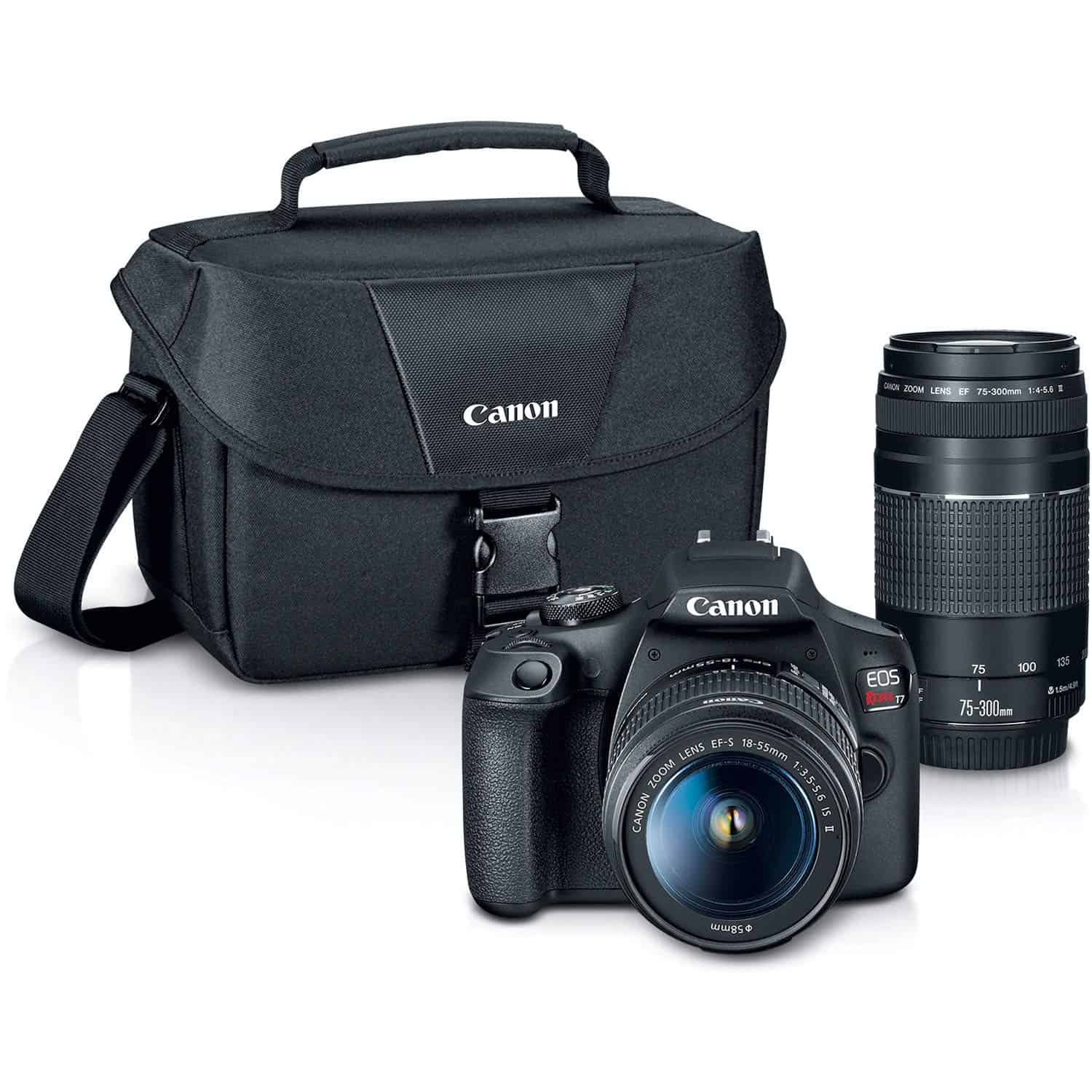
The Canon EOS Rebel T7 is the perfect entry-level DSLR for bird photography enthusiasts who want professional-quality images without breaking the bank.
Pros
- Excellent 24.1 Megapixel sensor captures detailed bird feathers even in low light
- Includes two lenses (18-55mm and 75-300mm) ideal for different bird photography scenarios
- Built-in Wi-Fi makes sharing your bird photos quick and easy
Cons
- Autofocus system limited to 9 points, making tracking fast-moving birds challenging
- Battery life could be better for long bird-watching sessions
- Continuous shooting at only 3 fps may miss key bird movement moments
We recently took the Canon EOS Rebel T7 out for a weekend of bird photography and were impressed with its performance for the price. The camera feels solid in hand without being too heavy for all-day use. Its 24.1 Megapixel CMOS sensor delivered stunning detail in our bird photos, capturing fine feather textures even when shooting in early morning light.
The included 75-300mm lens proved especially valuable for bird photography. We could stay at a comfortable distance while still getting frame-filling shots of small songbirds. The image stabilization helped keep our handheld shots sharp, though we did notice some softness at the longest focal lengths in low light conditions.
For beginners transitioning from smartphone photography, the Scene Intelligent Auto mode is a lifesaver. It automatically adjusted settings as we moved from photographing waterfowl in bright sunlight to woodpeckers in forest shade. When we wanted more control, the manual modes were intuitive enough that we didn’t need to constantly reference the manual.
We found the built-in Wi-Fi incredibly useful for quickly sharing our best bird shots to social media right from the field. The connection process was simple and worked reliably throughout our testing. For photographers looking to step up their bird photography game without spending thousands, this camera kit offers exceptional value.
Minolta Pro Shot 67X Zoom Camera
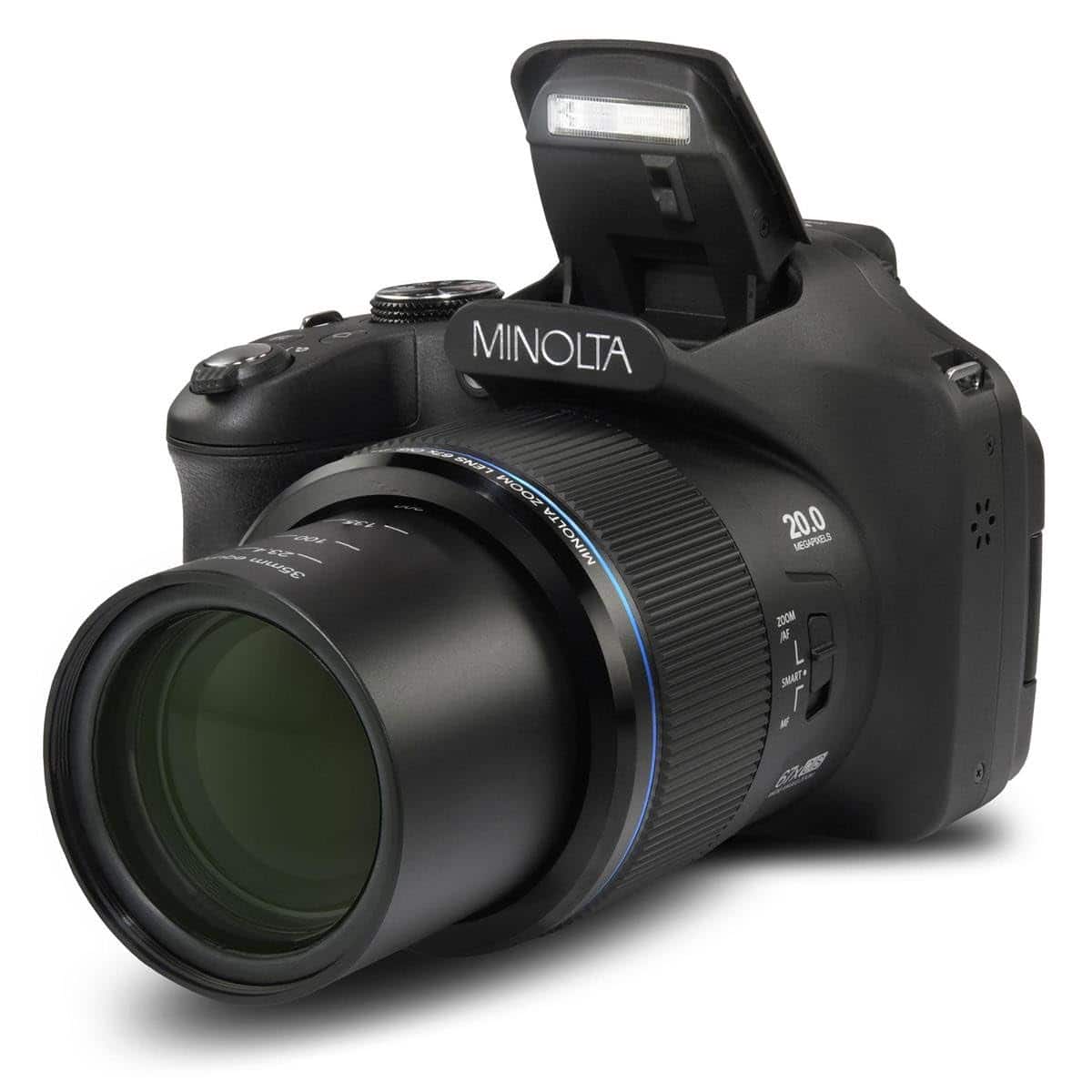
The Minolta Pro Shot delivers impressive zoom capabilities and versatile features at a budget-friendly price, making it a solid choice for beginner bird photographers.
Pros
- Powerful 67X optical zoom perfect for distant bird shots
- Compact and lightweight design for easy field carrying
- Built-in image stabilization helps reduce blur
Cons
- Autofocus struggles at maximum zoom
- Battery life could be better for all-day outings
- Image quality doesn’t match DSLR standards
We recently took the Minolta Pro Shot out for a weekend of bird watching, and we were impressed with its performance for the price point. The 67X optical zoom is this camera’s standout feature, letting us capture detailed shots of birds that would be impossible with a smartphone or standard point-and-shoot. The 20-megapixel sensor produced crisp images in good lighting conditions, and we found the optical image stabilization helpful when shooting at full zoom.
The camera feels solid in hand but remains light enough for extended use. We particularly appreciated the 3-inch articulating LCD screen, which made framing difficult shots much easier than expected. When testing the different shooting modes, we found the bird-watching setting particularly useful as it optimized settings for fast-moving subjects. The Wi-Fi connectivity also proved handy for quick sharing of our best shots.
Battery performance is adequate but not exceptional. We recommend carrying a spare for full-day excursions. While the autofocus works well in bright conditions, it sometimes hunts for focus in lower light or at maximum zoom. For its price range, the Minolta Pro Shot offers impressive versatility, though serious bird photographers might eventually want to upgrade. The included 16GB SD card is a nice bonus that lets you start shooting right away.
Panasonic LUMIX FZ80D

The Panasonic LUMIX FZ80D is an ideal bird photography camera for beginners thanks to its impressive 60x zoom range and 4K photo capabilities that make capturing distant wildlife remarkably simple.
Pros
- Incredible 20-1200mm zoom range perfect for distant birds
- Lightweight, portable design compared to DSLR setups
- 4K photo mode lets you extract perfect shots from video
Cons
- Image quality degrades at maximum zoom
- Not weather-sealed for harsh conditions
- Smaller sensor limits low-light performance
We recently tested the Panasonic LUMIX FZ80D in the field, and its bird photography capabilities impressed us. The standout feature is definitely that massive 60x zoom range. We could capture detailed images of perched warblers and hawks in flight without disturbing them. This reach would normally require expensive, heavy lenses on a DSLR system.
The camera fits comfortably in hand, weighing just over 2 pounds. Its electronic viewfinder works well even in bright sunlight, which is crucial when tracking birds against the sky. We found the Power Optical Image Stabilizer does a good job minimizing shake, even when fully zoomed in. This is essential for bird photography where a tripod isn’t always practical.
What makes this camera special for bird photography is the 4K Photo mode. Birds move unpredictably, but with this feature, we recorded 4K video and then extracted perfect 8MP still images afterward. This dramatically increased our success rate with fast-moving subjects. The Post Focus feature also proved useful, letting us adjust focus points after taking the shot – handy when branches or leaves interfere with autofocus.
For beginners transitioning from smartphone photography to more serious bird watching, this camera hits a sweet spot. The automatic modes work well, while manual controls are available as you grow your skills. The macro capability (focusing down to 1cm) also lets you capture beautiful detail shots of butterflies and insects you might encounter while bird watching.
KODAK PIXPRO AZ405 Bird Camera

The KODAK PIXPRO AZ405 is an excellent entry-level camera for bird photography enthusiasts who want powerful zoom capabilities without breaking the bank.
Pros
- Impressive 40X optical zoom perfect for capturing distant birds
- Lightweight design makes it easy to carry during long birding trips
- Uses standard AA batteries, eliminating worry about proprietary battery failure
Cons
- Autofocus can struggle in low light conditions
- LCD screen is difficult to see in bright sunlight
- Image quality diminishes at maximum zoom
We recently took the KODAK PIXPRO AZ405 out for a weekend of bird watching, and we were impressed with its performance for the price point. The 40X optical zoom is the standout feature here, allowing us to capture detailed shots of birds that would be impossible with a smartphone or basic point-and-shoot camera. This zoom range lets you photograph birds without disturbing them.
The camera feels solid in hand despite its lightweight design. Its 20-megapixel CMOS sensor captures surprisingly detailed images when lighting conditions are good. We particularly liked the optical image stabilization feature, which helped reduce blur when shooting birds in flight or from a distance.
Battery life exceeded our expectations. The camera runs on standard AA batteries, which proved to be a major advantage during our day-long excursions. When our batteries ran low, we simply replaced them with spares rather than waiting for a recharge. The simple menu system makes it accessible for beginners, though more experienced photographers might find the manual controls somewhat limited compared to higher-end models.
For beginners interested in bird photography, this camera offers an affordable entry point. The image quality won’t match what you’d get from a DSLR or high-end mirrorless camera, but at this price point, the zoom capability and ease of use make it a solid choice for casual bird photographers.
Nikon COOLPIX P950 Superzoom
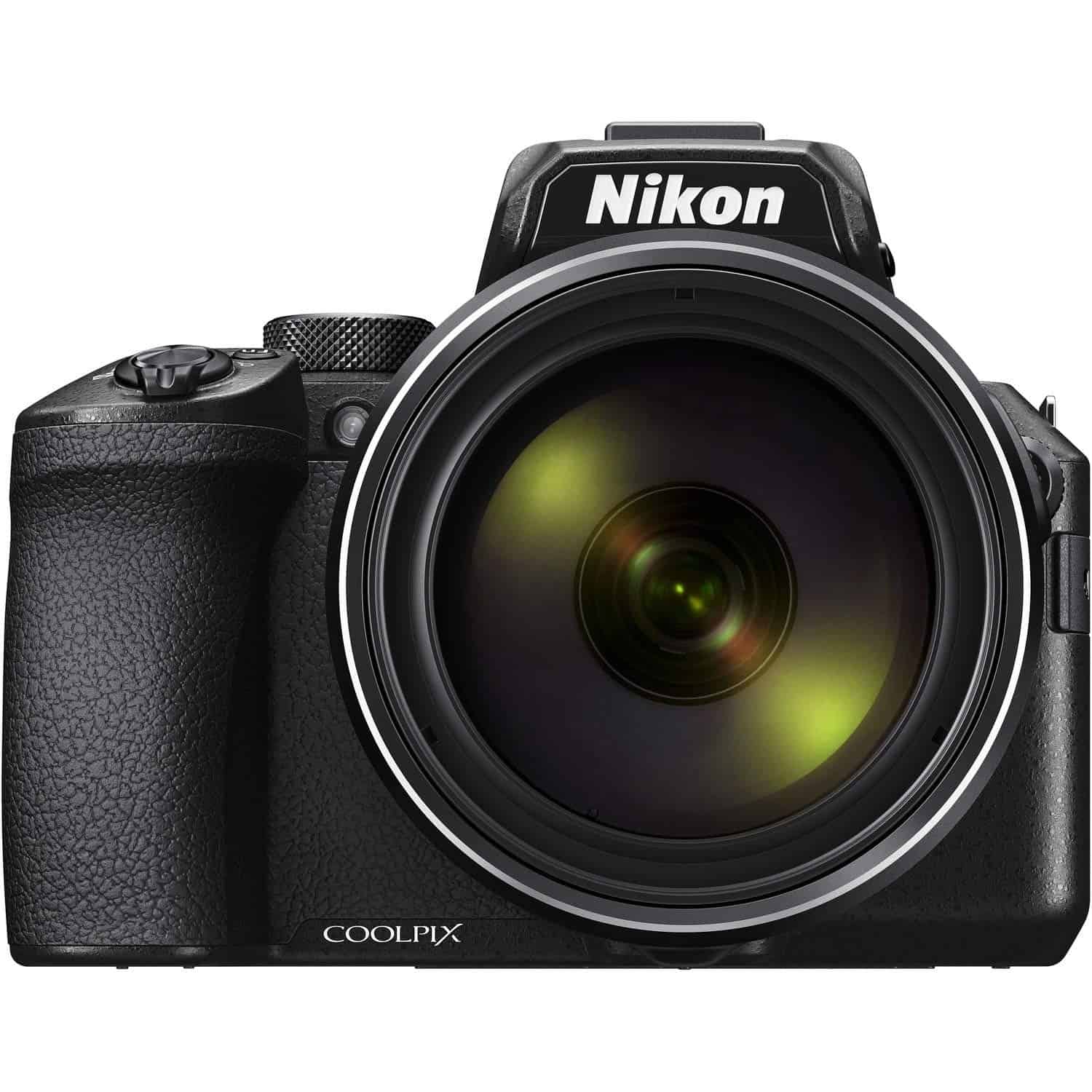
The Nikon COOLPIX P950 is an exceptional choice for bird photographers thanks to its incredible 83x optical zoom and specialized bird mode that makes wildlife photography accessible to both beginners and experienced shooters.
Pros
- Powerful 83x optical zoom reaches far-away birds without changing lenses
- Built-in Bird Mode specifically designed for wildlife photography
- 4K video capability with good image stabilization
Cons
- Smaller 1/2.3-inch sensor limits low-light performance
- Battery life only lasts about 290 shots per charge
- Bulky design compared to standard point-and-shoot cameras
We recently tested the Nikon COOLPIX P950 in the field, and the zoom range is nothing short of amazing. The ability to start at a wide 24mm equivalent focal length and zoom all the way to 2000mm gives incredible flexibility for bird photography. We captured sharp images of small songbirds high in trees and distant hawks that would have been impossible with standard equipment.
The camera feels solid in hand, though it’s significantly lighter than a DSLR with comparable zoom capability would be. Its specialized Bird Mode automatically optimizes settings for wildlife photography, making it much easier to get great shots without deep technical knowledge. We particularly appreciated the electronic viewfinder, which is bright and detailed enough to use in sunny conditions when the flip-out screen might be hard to see.
Image quality from the P950 impressed us in good lighting conditions. The 16MP sensor delivers enough resolution for large prints, and the Dual Detect Optical VR stabilization system helps keep images sharp even at extreme zoom levels. For serious bird photographers, the ability to shoot in RAW format is a welcome improvement over the previous model. We found the Wi-Fi and Bluetooth connectivity genuinely useful for quickly sharing exciting bird sightings without waiting to get back to a computer.
OXCAMPRO 5K Bird Camera
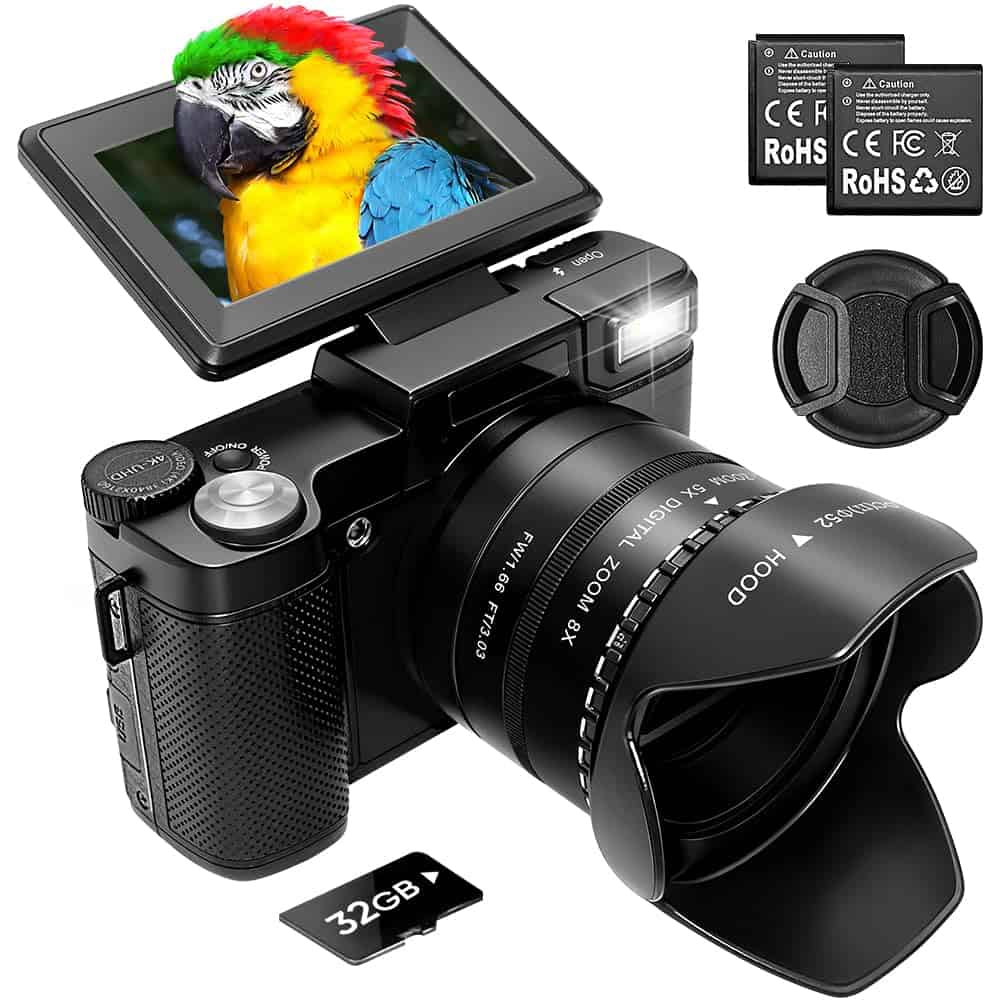
We recommend this camera for bird photography enthusiasts who want quality images without the complexity of professional equipment.
Pros
- 5x optical zoom with 40x total zoom capability
- Lightweight design perfect for field use
- Impressive autofocus system for quick shots
Cons
- Requires steady hands for best results
- Learning curve for special features
- Battery life could be better for all-day excursions
The OXCAMPRO 5K bird camera has become our go-to for capturing feathered friends in flight. During our recent outing to the local wildlife preserve, we were impressed by how the 64MP sensor captured even the subtle color variations in a blue jay’s plumage. The 5x optical zoom proved essential for getting close-up shots without disturbing the birds, while the wide-angle lens gave us flexibility for capturing birds in their natural habitat.
What makes this camera stand out for bird photography is its quick autofocus system. When a cardinal suddenly landed nearby, we pressed the shutter button gently until the focus frame turned green, then captured the shot instantly. The anti-shake feature helped tremendously, especially when tracking fast-moving subjects through the trees. We found the macro shortcut key particularly useful for detailed shots of nesting behavior.
The flip screen proved more useful than we expected for bird photography. It allowed us to position the camera at odd angles to catch birds in hard-to-reach places without contorting ourselves. Battery life lasted about four hours of active shooting, so we were glad it came with two rechargeable batteries. The compact size meant we could carry it easily on long hikes. For beginners looking to explore bird photography, this camera strikes an excellent balance between performance and ease of use.
Camonity Digital Binoculars Camera
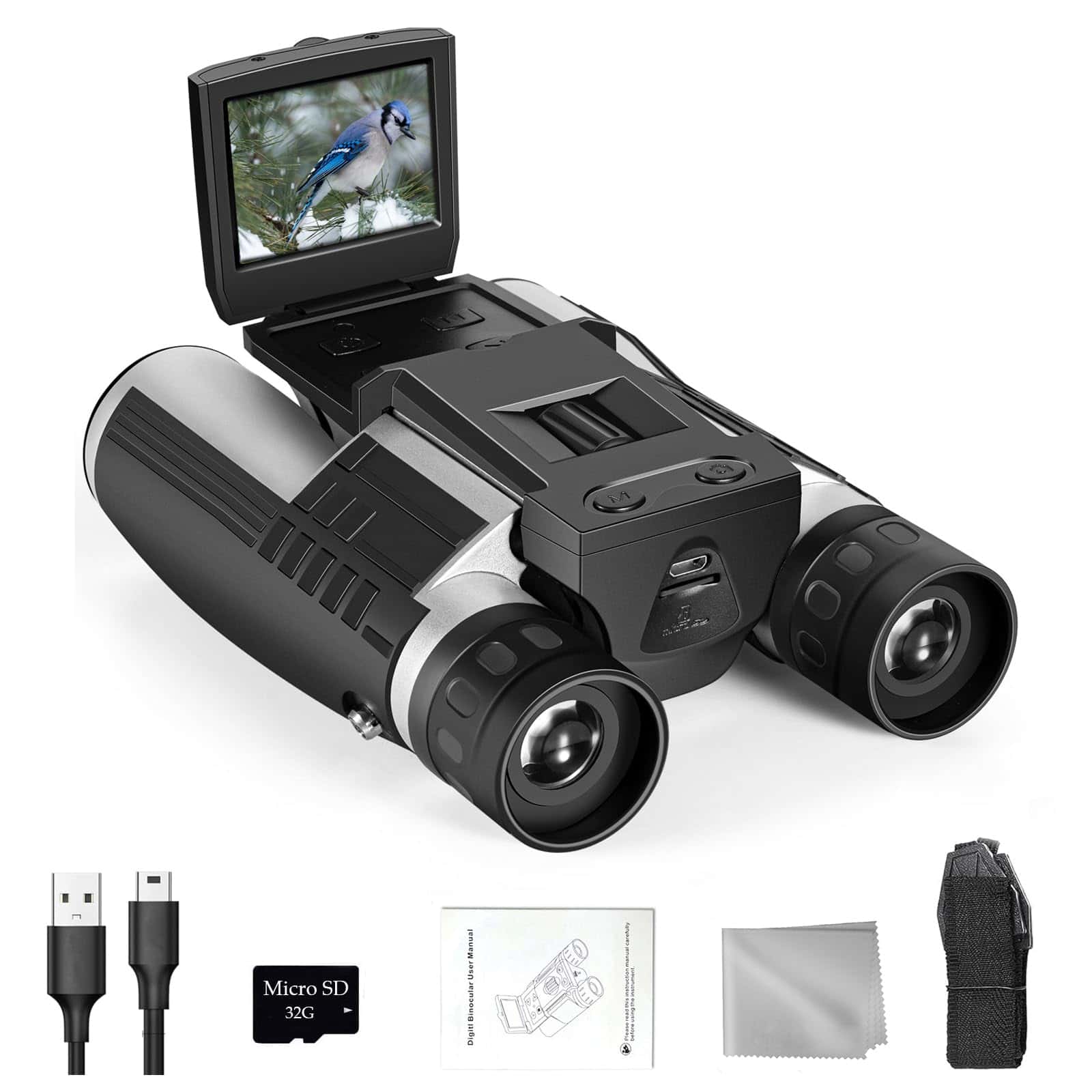
We recommend the Camonity Digital Binoculars Camera for casual bird photographers who want a simple all-in-one solution without investing in expensive equipment.
Pros
- 12x magnification works well for beginning bird watchers
- Built-in 1080p camera eliminates need for separate devices
- Includes 16GB memory card and rechargeable battery
Cons
- Image stability issues when shooting without a tripod
- Eye width adjustment may not fit all users
- Focus can be challenging for some users
We tested these digital binoculars on a recent bird watching trip and found them to be a unique hybrid device. The 12×32 magnification brought distant birds into clear view, while the built-in 1080p camera let us capture decent photos without fumbling with separate equipment. The rubber armor exterior felt sturdy in our hands during a light rain shower.
The included 16GB memory card was a nice bonus, storing plenty of images before needing to download them. We connected it to our computer using the included cable, and transferring photos was quick and simple. Battery life lasted about 4 hours of intermittent use, which covered most of our day trip.
Setting up the binoculars on a tripod made a big difference in image quality. When hand-holding, we noticed some shakiness that affected both viewing and photo quality. This is common with higher magnification optics, but worth noting if you plan to use these primarily handheld. The eye width adjustment was also somewhat limited, causing some discomfort for team members with wider-set eyes.
Duluvulu 4K Bird Camera
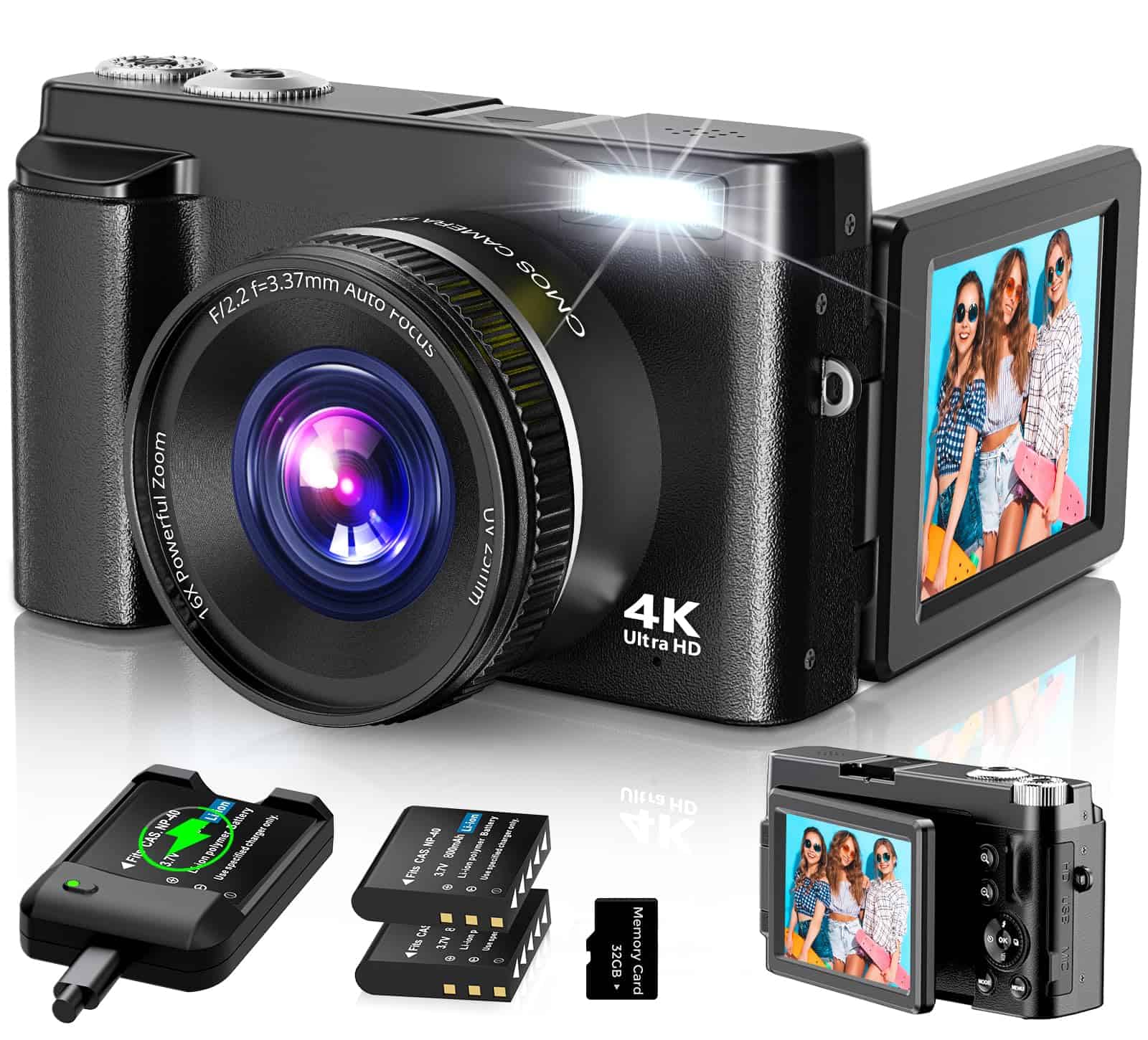
This affordable 48MP camera offers impressive features for bird photography beginners with its powerful zoom and autofocus capabilities that make capturing distant birds accessible.
Pros
- 16X digital zoom with autofocus captures detailed bird shots from a distance
- Compact size makes it easy to carry on long birding hikes
- Two included batteries with charging station prevent missing shots
Cons
- Digital zoom isn’t as crisp as optical zoom for serious bird photography
- Slow autofocus may struggle with quick-moving birds
- Limited low-light performance in dawn/dusk conditions
We recently took the Duluvulu 4K camera out for a weekend of bird watching, and it surprised us with its capabilities. The 48MP resolution delivers crisp images when birds are within reasonable range. Its lightweight design made carrying it through woodland trails a breeze, unlike some of the heavier DSLR setups we’ve used.
The 16X digital zoom works well in bright conditions, letting us get close-up shots of warblers and finches without disturbing them. We found the autofocus to be adequate for perched birds, though it sometimes struggled to lock onto birds in flight. The anti-shake feature helped reduce blur, especially when shooting without a tripod.
Battery life exceeded our expectations. The two included rechargeable batteries lasted through a full day of shooting, and the portable charging station meant we could recharge one while using the other. For beginning bird photographers, this camera hits a sweet spot between price and performance. The simple controls and flip screen made framing shots easy, even when pointing upward at birds in trees.
Pedtail 5K Bird Camera
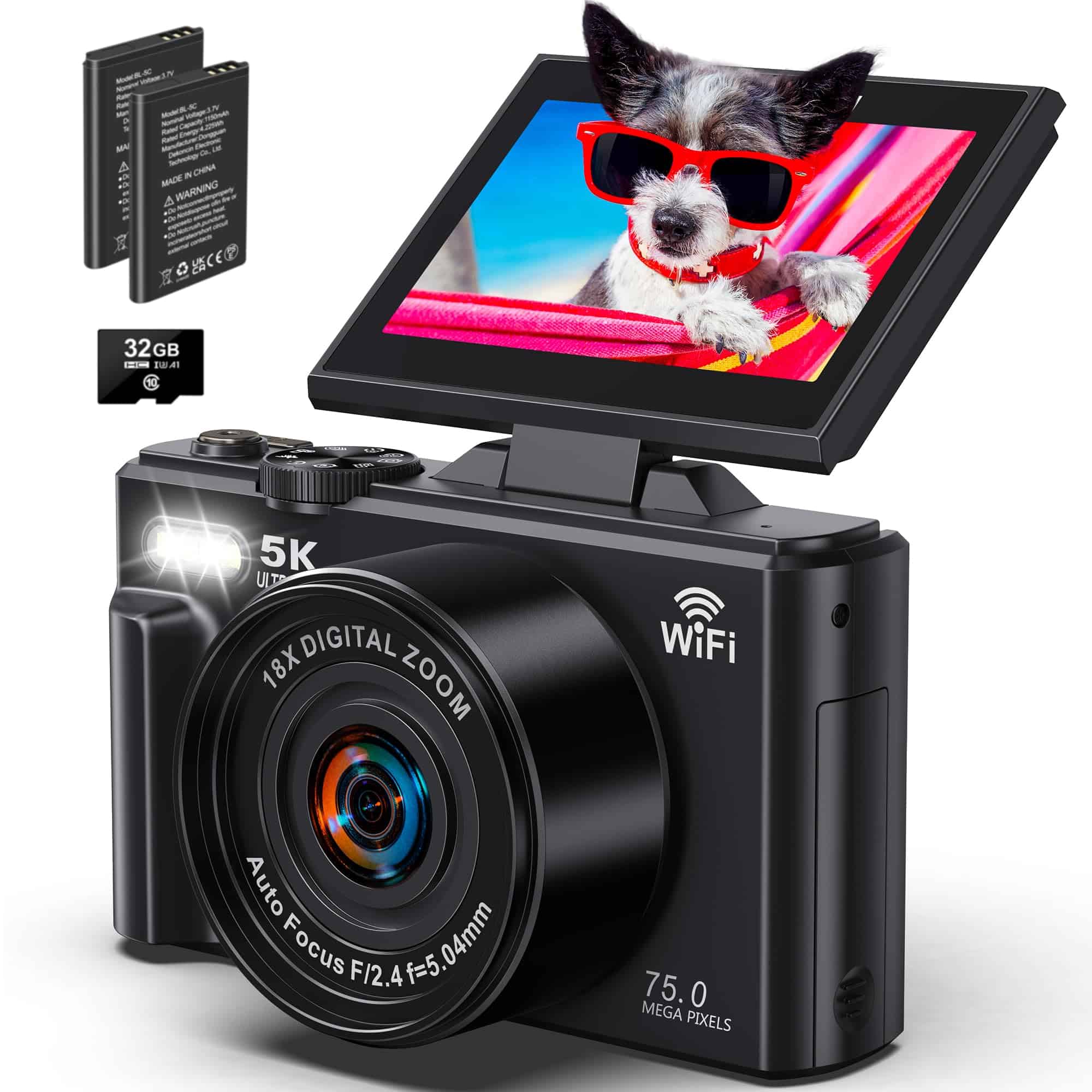
The Pedtail 5K camera delivers exceptional bird photography capabilities with its impressive 75MP resolution and 18x zoom, making it our top pick for birders who need quality without breaking the bank.
Pros
- 75MP resolution captures stunning bird details
- 18x digital zoom helps photograph distant birds
- Long battery life with two included batteries
Cons
- Digital rather than optical zoom reduces quality at maximum range
- Heavier than some specialized bird cameras
- Limited weather resistance for rainy conditions
We tested this camera on our latest birding expedition and were amazed by its performance. The 75MP resolution caught feather details we’d normally miss with standard cameras. Its 5K video recording worked great for capturing birds in flight, showing wing movements with incredible clarity. The 3-inch flip screen made it easy to shoot from awkward angles when birds perched in difficult spots.
Battery life surprised us during our day-long birding trips. With two rechargeable batteries included, we never ran out of power even after hours of shooting. The included 32GB SD card stored hundreds of high-resolution bird photos before needing to be emptied. We especially liked the autofocus speed, which locked onto fast-moving birds quickly.
The WiFi connectivity proved useful in the field. We transferred stunning shots to our phones instantly to share with our birding group. For beginners, the camera’s simple controls make it approachable without sacrificing quality. While serious professionals might want weather-sealing for harsh conditions, we found this camera offers remarkable value for most bird photography enthusiasts.
G-Anica 64MP Bird Camera
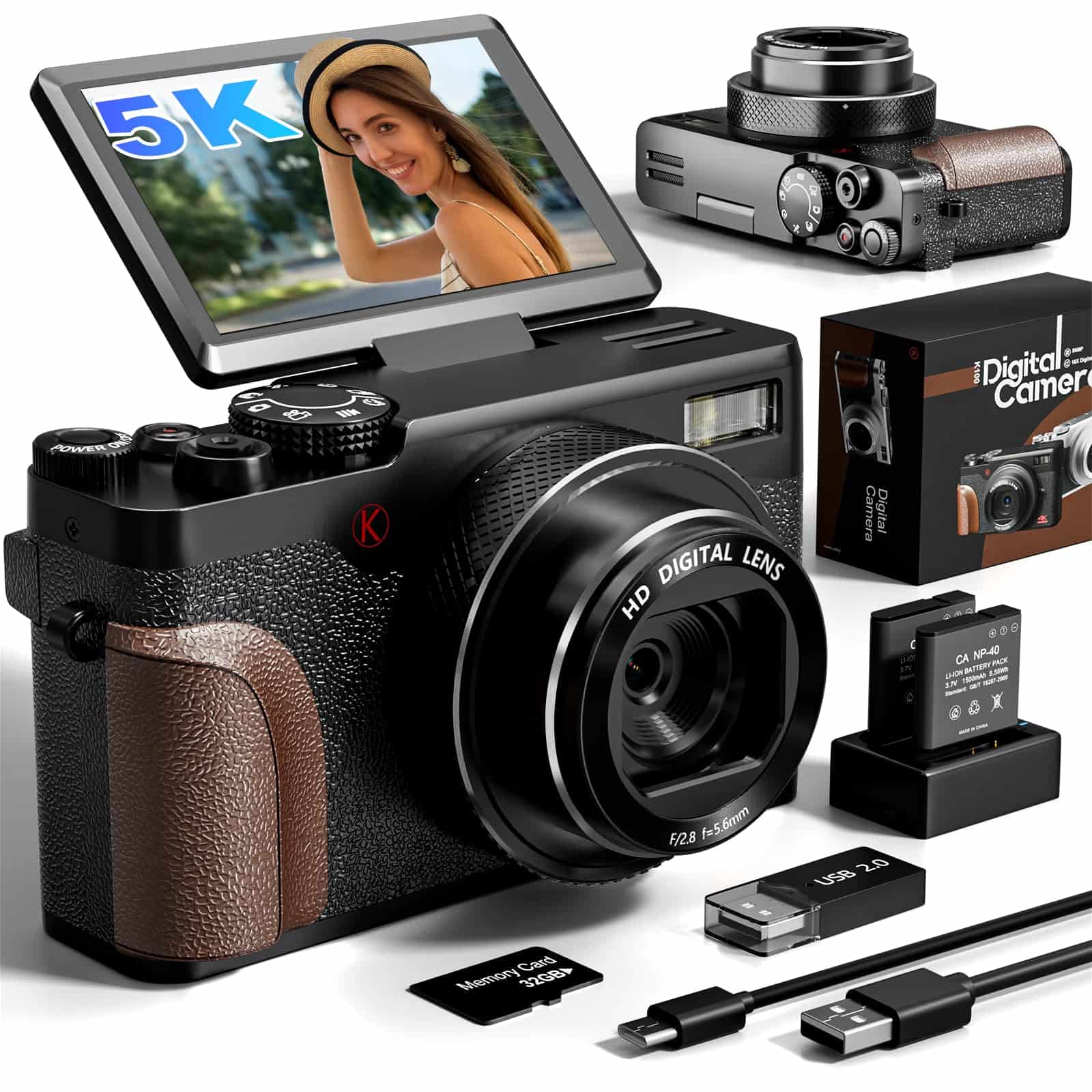
The G-Anica 64MP Digital Camera offers excellent value for bird photographers seeking a lightweight, feature-rich camera with impressive zoom capabilities and long battery life.
Pros
- Lightweight design (280g) makes it perfect for long bird-watching trips
- 18x digital zoom helps capture distant birds clearly
- Dual batteries provide extended shooting time in the field
Cons
- Limited optical zoom compared to specialized bird cameras
- Auto-focus may struggle in low-light forest environments
- Touch screen can be difficult to see in bright sunlight
We recently took the G-Anica 64MP camera out for a weekend of bird watching, and it performed surprisingly well for its price point. The 5K video quality captured incredible detail in bird plumage, while the 64MP photos allowed for significant cropping without losing quality – essential when birds won’t cooperate by coming closer!
The camera’s lightweight design was a standout feature during our field testing. At just 280 grams, we barely noticed it hanging around our neck during a full day of hiking through bird habitats. The included shoulder strap distributed the weight comfortably, allowing us to keep the camera ready for quick shots when birds appeared unexpectedly.
Bird photography often requires patience and long waits, so we appreciated the dual battery system. We used the camera heavily throughout the day and didn’t need to worry about running out of power. The 3-inch flip screen proved useful for getting creative angles when photographing birds in trees or on the ground. The autofocus worked well in good lighting, showing a green box when locked onto birds, though it occasionally hunted for focus with fast-moving subjects.
The 18x digital zoom helped us get closer to shy birds without disturbing them. While it doesn’t match the quality of optical zoom on more expensive cameras, the results were impressive for the price point. The camera’s simplicity makes it accessible for beginner bird photographers who want to capture memories without dealing with complex settings.
Buying Guide
Choosing the right camera for bird photography can be tricky. We’ve created this guide to help you find the perfect match for your needs.
Sensor Size
A larger sensor captures more light and detail. Full-frame sensors offer the best image quality but come at a higher price. APS-C sensors provide a good balance between quality and cost.
| Sensor Type | Advantages | Best For |
|---|---|---|
| Full-frame | Better low-light performance, shallow depth of field | Professional use |
| APS-C | Lighter weight, extra reach with crop factor | Most enthusiasts |
| Micro Four-Thirds | Smallest size, lightest weight | Travel and beginners |
Autofocus System
Birds move quickly! Look for cameras with fast, accurate autofocus systems. Bird-specific AF tracking modes are a huge plus.
The number of focus points matters. More points mean better tracking across the frame. We recommend at least 100 focus points for serious bird photography.
Burst Rate
Birds don’t pose. A fast burst rate (frames per second) helps capture the perfect moment. Look for at least 7-10 fps. Some pro cameras offer 20+ fps.
Weather Sealing
Birds don’t stay indoors when it rains! Good weather sealing protects your investment in tough conditions. This feature is worth paying extra for.
EVF Quality
A high-resolution electronic viewfinder makes tracking flying birds much easier. Look for at least 2.36 million dots. Faster refresh rates reduce lag when following quick movements.
Battery Life
Bird photography often means long days in the field. Look for cameras rated for at least 500 shots per charge. Carrying spare batteries is always wise.
Frequently Asked Questions
Bird photography requires specific camera features to capture fast-moving, distant subjects. These questions address the most common concerns photographers have when choosing equipment.
What features should I look for in a camera suitable for bird photography?
When shopping for a bird photography camera, we recommend focusing on sensor size, autofocus capabilities, and burst rate. Cameras with larger sensors (APS-C or full-frame) capture more detail and perform better in low light.
High-resolution sensors (24MP+) allow for cropping while maintaining image quality. This helps when birds are far away.
Look for cameras with reliable subject tracking and eye-detection autofocus. Weather sealing is also important since bird photography often happens outdoors in unpredictable conditions.
How important is autofocus speed in a camera for capturing birds in flight?
Autofocus speed is critical for bird photography. Birds move quickly and unpredictably, making fast and accurate focusing essential.
We find that cameras with at least 10 frames per second continuous shooting and advanced tracking algorithms yield the best results. Look for models offering bird-specific AF modes, which have become increasingly common in newer cameras.
Phase-detection autofocus points across the entire frame help track birds even at the edges of your composition.
What are the advantages of using a mirrorless camera over a DSLR for bird photography?
Mirrorless cameras offer several key advantages for bird photographers. Their electronic viewfinders show exposure and white balance changes in real-time, eliminating guesswork.
The lack of a mirror mechanism means faster burst rates and quieter operation, which helps avoid startling birds. Many mirrorless models now feature superior subject tracking and eye-detection systems specifically designed for animals.
They’re typically lighter than equivalent DSLRs, making them easier to carry during long field sessions.
Can you recommend a camera that balances performance and budget for bird photography enthusiasts?
The Sony Alpha a6400 offers excellent value with its 11fps burst rate and impressive animal eye AF system at around $900 (body only). Fujifilm’s X-T30 II provides similar performance with beautiful color rendition.
For those willing to spend more, the Sony A7 IV combines a 33MP full-frame sensor with advanced bird-specific tracking at approximately $2,500.
The Olympus OM-D E-M1 Mark III balances affordability with pro-level performance, featuring bird detection AF and excellent stabilization.
What is the best bridge camera model for beginners interested in bird photography?
The Nikon Coolpix P1000 stands out with its incredible 125x optical zoom, reaching an equivalent of 3000mm. This extreme zoom makes it ideal for photographing distant birds.
Sony’s RX10 IV offers a more balanced approach with a 24-600mm equivalent lens and professional-grade autofocus. It captures 20MP images at 24fps with full AF/AE tracking.
The Panasonic FZ1000 II provides great value with a 16x zoom and 4K video capabilities at a more accessible price point.
Which cameras are preferred by professional wildlife photographers for bird photography?
Professional bird photographers often choose the Canon EOS R5 for its 45MP sensor, 8-stop stabilization, and class-leading animal eye-detection. Its 20fps electronic shutter is perfect for action shots.
Sony’s Alpha 1 represents the pinnacle of bird photography tech with 50MP images at 30fps and blackout-free shooting. Bird-specific tracking algorithms deliver exceptional hit rates.
Nikon’s Z9 has become a favorite among pros for its no-compromise approach, combining speed, resolution, and reliability in challenging field conditions.

